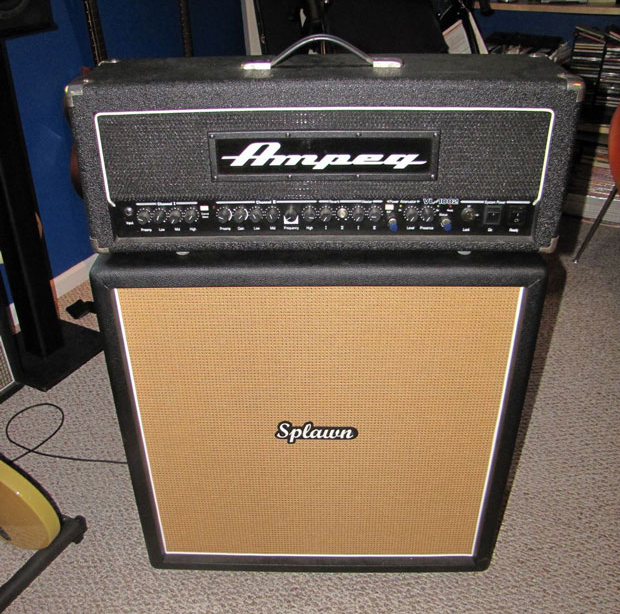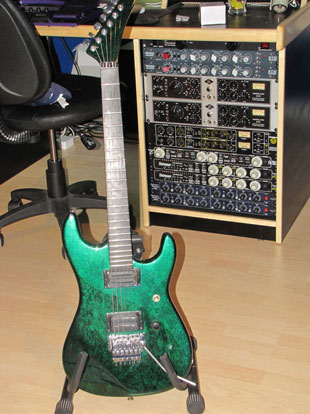Killer Guitar Tracks: Re-Recording Collective Soul's “Shine”

Last time, we talked about microphone placement and some general guidelines to consider. If you've had a chance to do some experimenting, you've probably found out that small changes in mic placement make big changes in tone.
Now let's touch briefly on the subject of recording levels and the importance of proper gain staging. If your signal chain consists of one mic into a pre and then into your recording interface, then it's pretty simple.
Today's modern digital interfaces have such a ridiculously low noise floor that you really don't have to stress too much about getting the maximum level. What you don't want is digital clipping, so shoot for about halfway to three-quarters of the way up the meter.
If you feel like the level looks too low when you compare it to other waveforms, you can always "gain it up" later. Pro Tools makes this real easy by using their audiosuite plugin for gain.
If you're running through some outboard gear like a compressor, or maybe you're going through a console, it's important to observe proper gain staging. Basically this means optimizing your input and output levels so you don't wind up amplifying any line noise from each preceding piece of equipment.

Recently, my band Collective Soul embarked on the massive undertaking of re-recording a bunch of our hits from the '90s. Basically this allows us to be more in control when it comes to licensing, movie placements, etc.
It probably goes without saying that the most important thing is to make these songs sound as close to the original as possible. After all, these are the songs people grew up with, so they are quite familiar with the sound of the records, not just the performances.
Get The Pick Newsletter
All the latest guitar news, interviews, lessons, reviews, deals and more, direct to your inbox!
This can be quite a balancing act, especially since some of these songs were actually demos. "Shine," for instance, was actually a demo that became so popular that when Atlantic signed the band, they weren't even interested in making a "proper" recording of it.
When we re-recorded it, we were faced with the dilemma of just how "basement" do we want to take this thing? In the end, we tried to strike a balance, and hopefully we succeeded. We opted for real drums instead of the Drum Kat drum machine on the original. The guitar solo I played was close to the original but with a few twists, just to put my spin on it.
To me, one of the most important parts to nail was the main riff that starts the song and becomes the verse. I asked Ed what he used on the original, and after he went through his memory banks, he said he was pretty sure that tone was a Rickenbacker guitar through an Ensonic DP4 rack module. Well, I decided that I would take a stab at it using the stuff I had lying around, since that Ensonic piece was long gone, and if I needed to, I could always borrow somebody's Rick.
The first thing I did was import the original song into the session so I could easily compare the sounds. After trying many amps and guitars, what I came up with was a combination I would have never expected to work, but I have to say I got really close -- I mean scary close.
The guitar was a homemade job I made back in high school using Warmoth parts, loaded with X2N pickups and a Floyd Rose! The amp I used was an old Ampeg Lee Jackson-designed head I bought new in the early '90s. By the way, that’s a great amp you can now find on the used market for very little cash. You’ll want to get it worked on because they had some issues, but it can cover a lot of territory.
Anyway, I guess the moral of the story is to keep an open mind about the gear you choose when you're recording guitars -- or anything else, for that matter. You might be surprised what you come up with to get the job done!
-- Joel
Joel Kosche is the lead guitarist for the chart-topping band Collective Soul. Prior to joining the group in 2001, he was a fixture in the Atlanta music scene, playing in local bands and working part time as a guitar tech for various artists, including Steve Winwood. When he’s not on tour or in the studio, Joel, a self-professed "gearhead" and “tinkerer,” enjoys building and modifying guitars and tube-based amps. Outside of his duties with Collective Soul, he has appeared on numerous recordings, including the epic "Shadowman" from Kansas lead singer Steve Walsh. Most recently, Joel released his first solo record, Fight Years, a self-produced effort recorded mainly in his home studio (Flame Under Heel Studios) and released in June 2010.









